A bit of cryptography: the mysterious and legendary Enigma
Secretly penetrating the intentions and intentions of the enemy, identifying his strengths and weaknesses, foreseeing, and hourly preventing plans - this is what constitutes the phenomenon of intelligence. The beginning of the last century rightfully deserves the title of the heyday of the art of intelligence and counterintelligence. This article is not a chanting of the German anthem of the Second World War, but another reminder of how much effort was put into victory in the distant 40s of the last century. After all, by the beginning of World War II, Germany had become the world leader in the production of special equipment in this field. A variety of tape recorders, including small-sized, miniature microphones, eavesdropping systems were considered the best in the world, because they were developed in accordance with the latest achievements of German science in the field of radio engineering and chemistry.
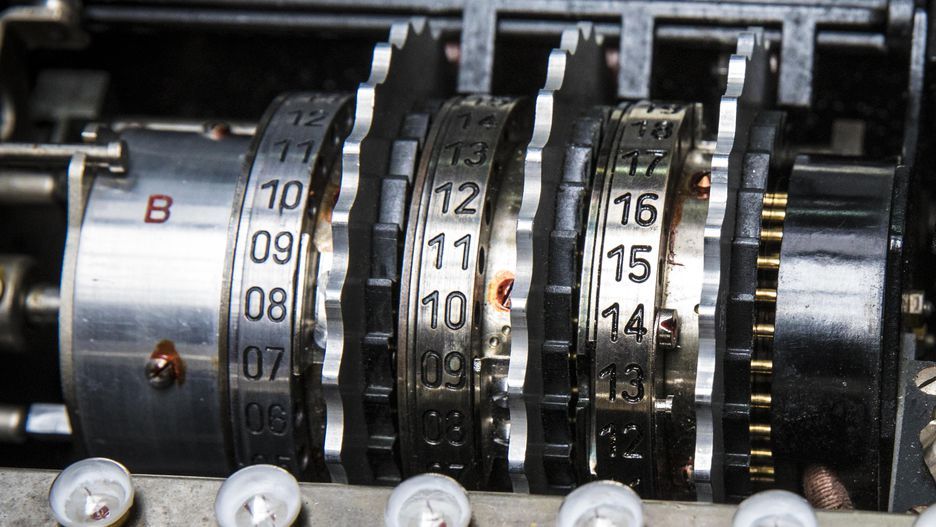
Only a few copies of Enigma, the most complex cryptographic machine of the Hitler Reich, were able to survive the war: loyal soldiers of the fascist army, surrendering, destroyed it by the thousands. Today, few can tell about the encryption technique used in the legendary "Riddle".
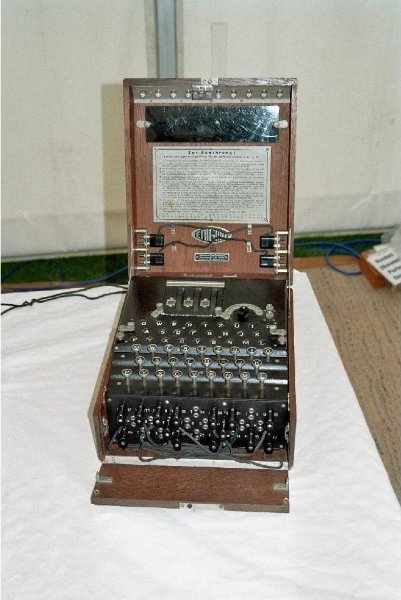
After the troops of the Southwestern and Stalingrad fronts closed the encirclement ring in 1943 (the Stalingrad cauldron, in which there was an almost 300,000th enemy group), the radio operator German Kledits was fortunate enough to remain outside the encirclement. The radio operator received the last message encrypted on Enigma from the comrades who were in the boiler. He still remembers its contents: in a cramped basement we are fighting X The enemy took up flamethrowers X Let Germany live. Then another clear-text message came: convey respect to my parents.
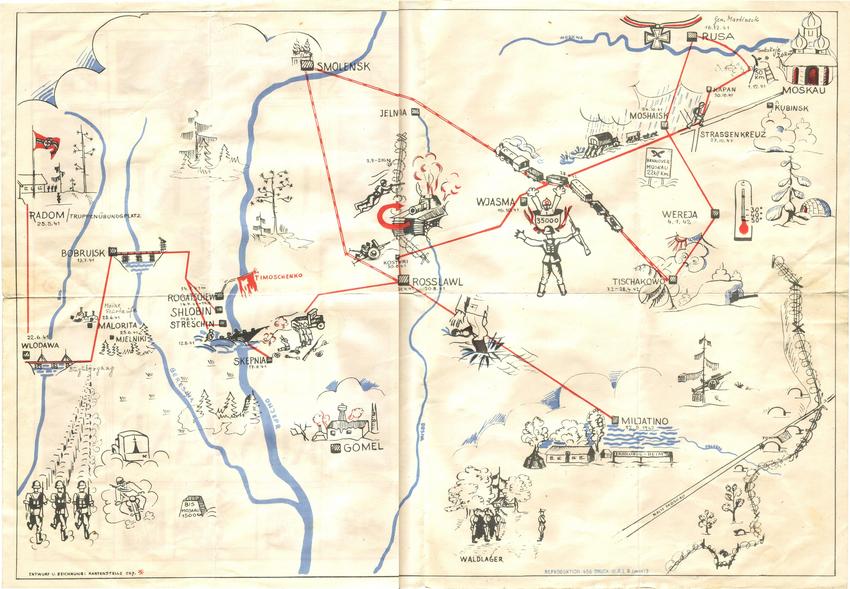
The German government, struck by the reliability of the machine, retained all rights to it for itself and began to use it for the army. Enigma was the most sophisticated encryption system used by the Germans during World War II. To communicate via Morse’s radio channel with troops at the front, soldiers used a much simpler system: double encryption.
German Kledits, born in 1921, and Jürgen Reinhold, born in 1923, are among the few surviving witnesses who were able to talk about their work with Enigma of our time.
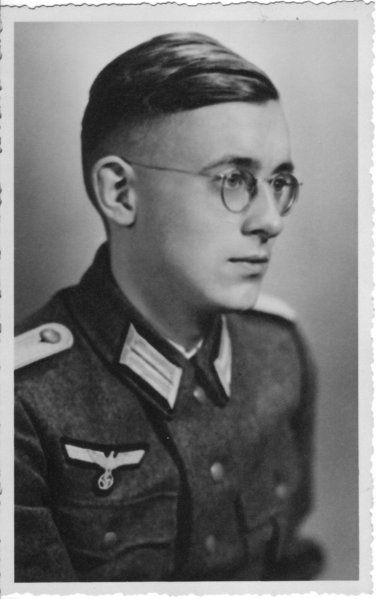
Under the Wehrmacht, Kledits in 1939 learned to be a telephone operator, and then a radio operator. At first he served in France in an infantry division, with which he went to the East in 1941. Inside, units worked only with double encryption. At the beginning of 1942 he was transferred to the intelligence unit, which was engaged in wiretapping and analysis of Soviet messages transmitted by wireless telegraph. Subsequently, the unit advanced through the territory of the USSR, conducting radio interception and using advanced technologies, the last point was Stalingrad.
Kledits was a radio operator. Analysis of intercepted messages was carried out by other specialists (mainly mathematicians) of the same unit. German had little contact with them and did not know anything about their secret work. And today, information about the work of German cryptographers in World War II is extremely fragmented.
However, Kledits could have guessed what his colleagues were doing. As a radio operator, he was faced with the task of transmitting messages to the military headquarters via the Morse apparatus. To prevent these strictly confidential data from falling into the hands of the enemy, they were encrypted using Enigma. As Kledits recalls, three people were always responsible for encryption: one entered the appropriate letters on Enigma, the second encrypted the result, and the third wrote it down.
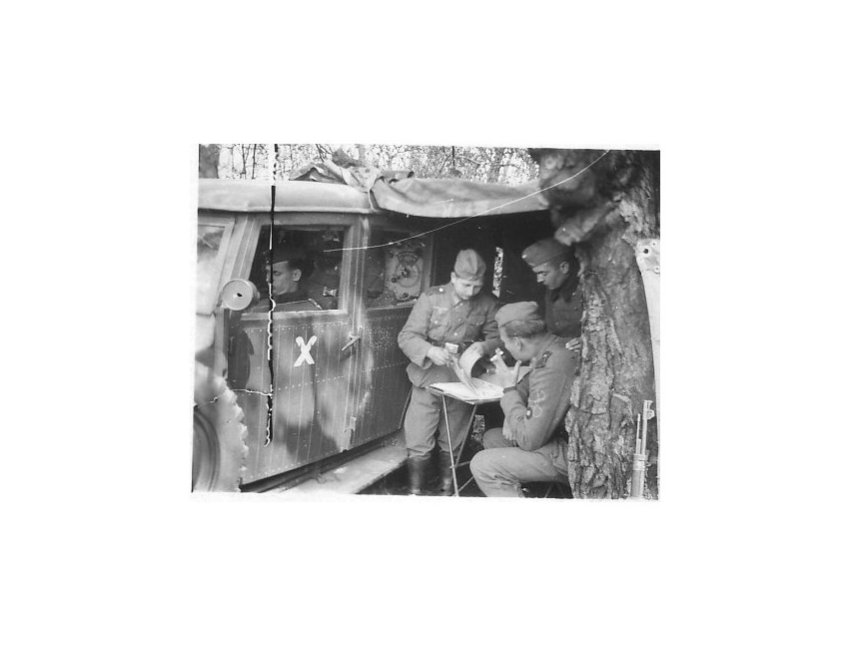
For the transmission of encrypted messages to occur correctly, the radio operator had to set the correct key (consisting of digital combinations). Each detachment had a list of codes with them, from which each time an officer took a part to pass on to a radio operator. Such a key was valid for 24 hours.
“We were convinced that Enigma could not be hacked,” said Jürgen Reinhold, one of the specialists of another unit. He was drafted in 1941, served in the intelligence department in the tank troops, for which he studied for nine months. At the same time, he studied Morse code, learned double encryption and working with Enigma. The Germans used several tens of thousands of this device during World War II - not knowing that the British were listening and decrypting most of the messages.
Jürgen Reinhold had no idea about this. For the transmission of the most important strategic and state-important messages of Enigma there was a choice of “namber van”. Only after it became known about Enigma's vulnerability did they return to the double encryption method. How it worked from the Reinhold story: it was necessary to look for vertical pairs of numbers in fields A and B, form a quadrangle, form the next quadrangle, and enter the result in five-digit groups of characters in Morse code.
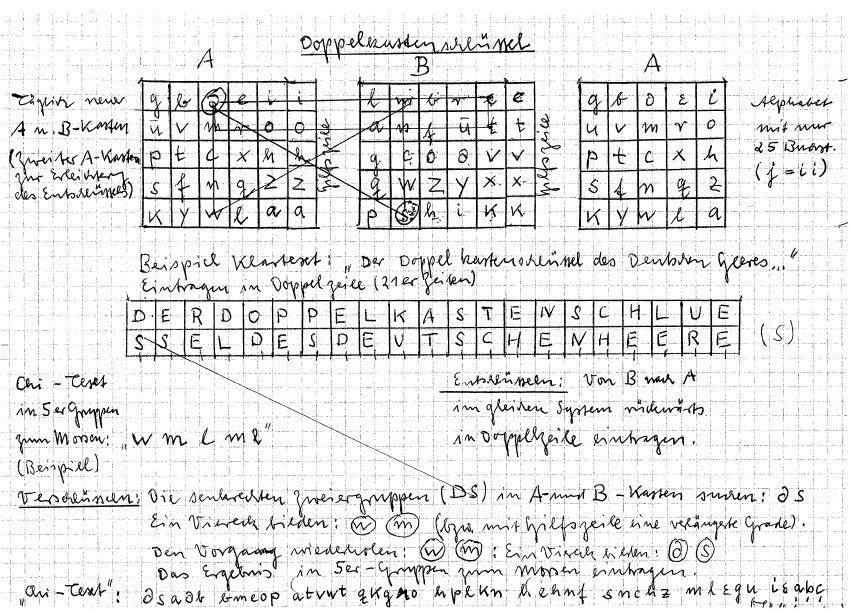
The difference is in the use of Enigma and double encryption on the face: the cipher was the size of a typewriter and, accordingly, too bulky for camping equipment, and therefore unsuitable for soldiers who fought at the front and moved on foot. The "paper and pencil" process used in double encryption was the best alternative for such units. In addition, front news was often very old in a couple of hours, and even the best crackers of the enemy’s code couldn’t work so fast.
In November 1942, the Kleditsa detachment arrived at Stalingrad. There, a radio group was visited by a group of Romanian intelligence officers. They were impressed by the work of the legendary Enigma. “Ah, la machina dechifrata!” - that’s what fell off their lips, because they were also delighted with the high security of the device, not suspecting that the British had long been able to break into Enigma.
Soon after the military success of the USSR and the Stalingrad boiler, the Kleditsa unit was dispersed. The retreat began. In Czechoslovakia, a scattered group gathered again in order to destroy their copy of Enigma on May 9, 1945. Even during the exercises, radio operators were taught some things: Enigma should never fall into the hands of the enemy, and the encryption key recorded on paper should be eaten during a disaster. Radio operators even practiced "eating" paper.
Jürgen Reinhold survived the end of the war in Hungary. Even after the war ended on May 8, 1945, he still used a cryptographic machine. He wanted to leave Hungary and get to the British, but was afraid of the Red Army. Using messages encrypted on Enigma, he, under the guidance of former comrades, was able to reach his destination. His cipher machine model was reliable: the device always worked flawlessly from start to finish. After Jurgen, taking the hammer, destroyed the last Enigma.
Since most soldiers destroyed their Enigma, only a couple of copies of the crypto machine have survived to date. Collectors are willing to pay about 20,000 euros for the legendary Enigma, and the cost of special models is even higher.
Simplicity of design, high reliability, and most importantly excellent cipher durability are the parameters that have made the Enigma cryptographic machine known for centuries. The electromechanical encoder first appeared after the First World War. In 1917, the American Edward Hepburn created a rotary encryption machine, it was later called "Enigma". She connected to an electric typewriter. In 1923, the Berlin engineer Arthur Sherbius created an independent industrial version of Enigma.
Over time, a special modification designed for the naval forces saw the light, it differed from the usual Enigma in the number of encryption rotors.
A large family of different Enigma machines was developed between 1923 and 1945. Conventionally, a family can be divided into two branches: machines with a more complex mechanism — they output information directly to paper, and simpler ones that are produced with incandescent lamps.
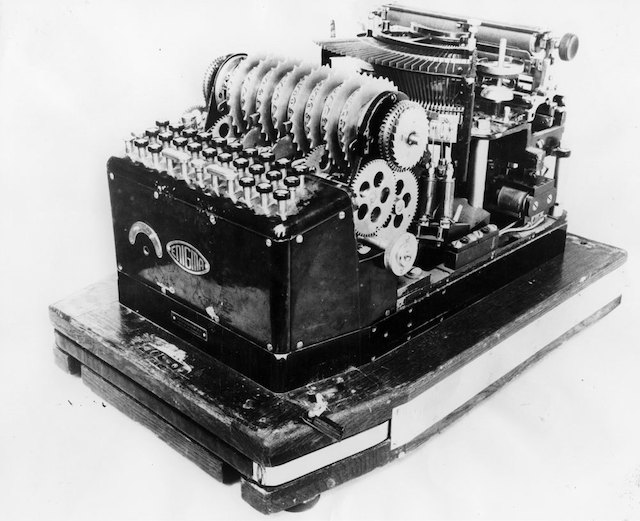
Enigma With
Enigma A - Die Handelsmaschine (commercial machine) was a printing encryption machine developed in 1923 by Scherbius & Ritter in Berlin (Germany). This was the first encryption device manufactured under the Enigma brand. As far as we know, there are currently no surviving examples of this model. The insecurity of the Enigma A printing mechanism led to the development of a new machine model in 1924.
The new model has a lettering lever (Typenhebel) - exactly the same as a conventional typewriter. Due to mechanical and manufacturing problems, the “introduction” of the crypto machine was delayed until 1926. In 1926, it was replaced by Die Schreibende Enigma (printed Enigma).
Machine with 4 encryption rotors and 28 electrical contacts on each side, with a gear mechanism with stepwise displacement. In addition, each gear wheel had a different number of teeth, which ensured a long encryption period and irregular (i.e., less predictable) stepping. Four encryption rotors were installed inside the machine, their initial position was set by 4 handles (on the right). By inserting the handle into the fifth handle (located at the very top), the entire encryption mechanism could be started. Above the encryption rotors was a 5-digit counter, with its help the number of characters entered on the keyboard was counted.
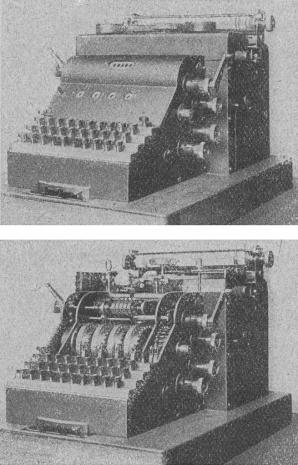
On the front of the crypto machine there was a knob for choosing 3 modes: encryption, decryption, and plain text. If the “plain text” mode was set, Enigma worked like a simple typewriter.
At the top of the machine, at the back, was a functioning printer, like a standard electric typewriter of that era. It consisted of a paper carriage and a petal printer. When creating encrypted text, characters were printed in groups of 5 letters each, after which a space was automatically set. One such line fit ten such groups (50 characters). On the keyboard were letters, numbers, punctuation marks, and a space. Two Shift keys were used to switch between letters and numbers.
Schreibende Enigma was subject to mechanical problems, so it was decided to develop another model. It was introduced in 1929 and became known as the Enigma Model H29 or simply Enigma H. H29 is the latest model in the Enigma series of printing machines. But, alas, these models were unreliable, and, despite improvements, in practice they received a lot of complaints.
It was Enigma A, which was initially much smaller and cheaper, turned into Enigma I - the main encryption device of the German army during the Second World War. Portable Enigma A was placed in a wooden box, it was first used light bulbs.
In November 1924, the car could be purchased for $ 500. With the purchase of 10 or more units, the price was $ 420, and for bulk purchases from 50 units - $ 400. It is known that there were several options for the car, but none of them survived.
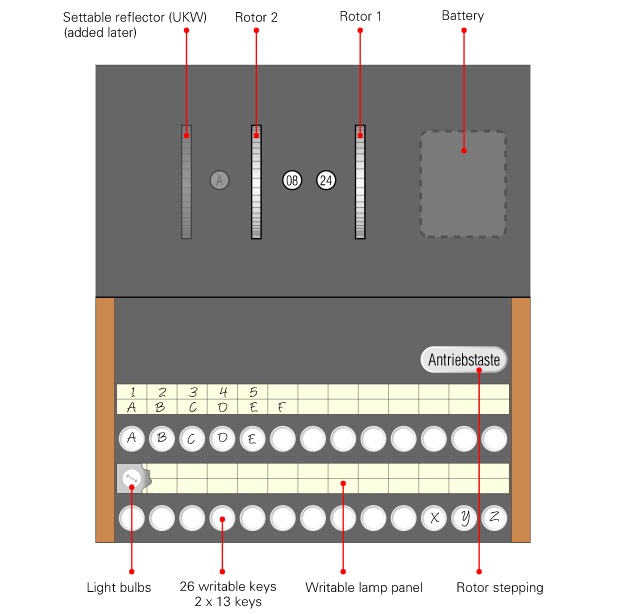
According to the description in the surviving documents, this is exactly what Enigma A looked like (photo above). Its dimensions were 27 x 23 x 13 cm, and weight about 5 kg. The keyboard consisted of 26 keys, divided into two rows. Above each row were corresponding bulbs. The keys were empty, any character could be entered on top.
Enigma B, an electromechanical encryption rotary machine, was introduced at the end of 1924 by Cipher Machine Corporation (ChiMaAG) in Berlin (Germany). Like its predecessor Enigma A, bulbs were used here.
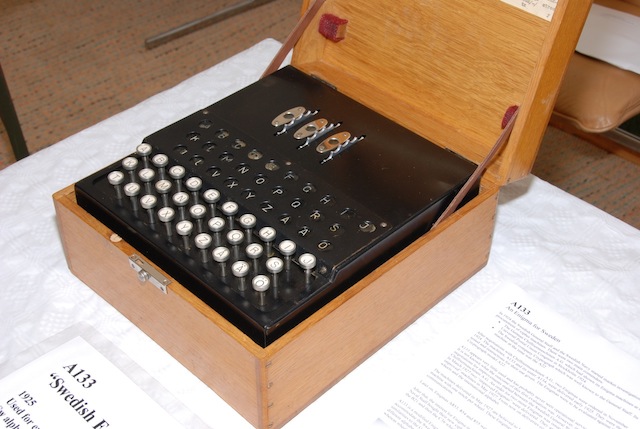
Two versions of Enigma B are known: an early version with two rows of keys in front and two rows of bulbs above the rotors; two fixed encryption rotors and a movable contact reflector in the center.

In a later version, one encryption rotor was removable. The keyboard was arranged a little differently than a conventional typewriter, the characters were arranged in alphabetical order. The lamp panel was now in the center of the machine, and the rotors moved back.
The letter W was missing; Å, Ä and Ö were added in the lower right corner. At that time, W was not used in the official Swedish language, with the exception of names, foreign words and borrowings, and in this case it could also be replaced by VV (double-V).

It is believed that surviving examples of the early Model B do not exist. But there are at least two copies of the later model (A-133 and A-134), they have become part of the collection. The differences between the two versions are so great that the later one is more likely a transition to Enigma C.
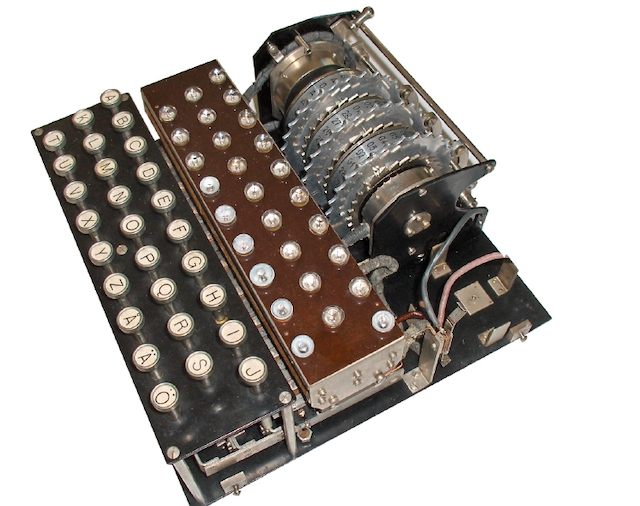
Inside the A-133, the
A-133 had three moving encryption rotors - one letter (AO) and the other two numbers (01-28) - and a fixed reflector (FM) mounted to the left of the rotors. The number of possible settings is 2 891 341 824.

The Enigma C, an electromechanical rotary encryption machine, was introduced in mid-1925 by Cipher Machine Corporation (ChiMaAG) in Berlin (Germany). Like its predecessors, Enigma A and Enigma B, it used bulbs.
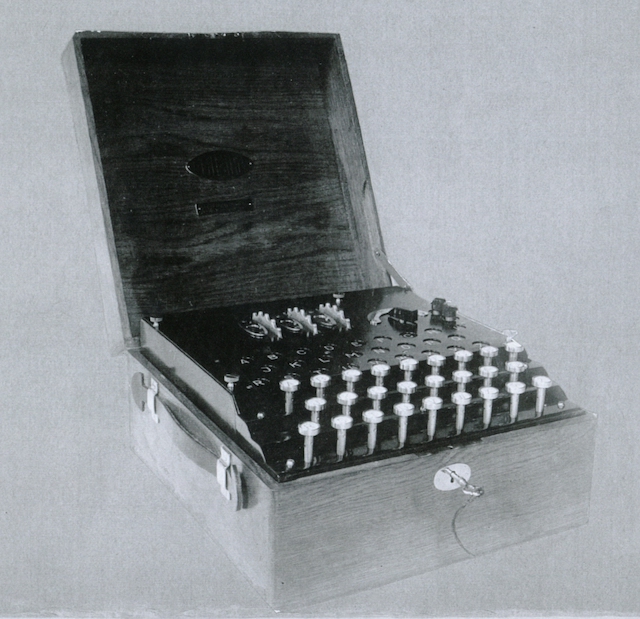
Components of Enigma C: 26-letter keyboard for entering open messages; 26 light bulbs, which when turned on illuminated the desired letters of the ciphertext; power source (3.5-volt battery or its equivalent); three removable contact wheels that rotated on a common axis; fixed contact reflector; fixed input contact wheel.
Enigma I is an electromechanical encryption machine developed in the years 1927/29 for the German army and put into operation in 1932. The basis was taken Enigma D, was added a fixed reflector and a control panel in front. The machine was used during the Second World War and was known under various names. Since December 1938, Enigma supplied with five disks instead of three: three - in the car, two remote. The German military insisted on making changes that significantly increased the durability of the machine. The most important of these was the introduction of the switch, which was located under the keyboard. 26 switch connectors were connected in pairs by 13 short cables. This device made it possible at the input and output stages to swap the letters of the alphabet that make up the pairs.
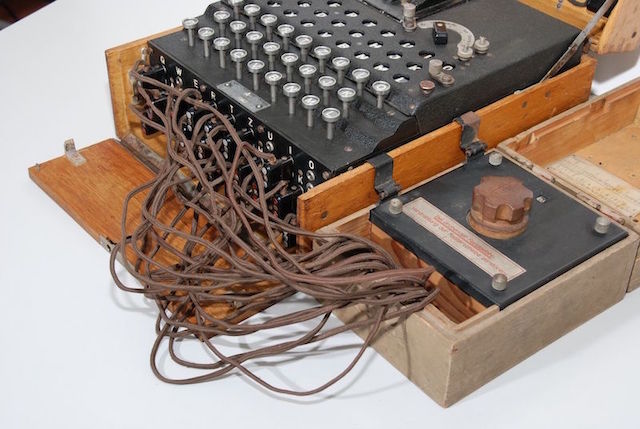
This instance was found in Italy, in a train among lost luggage at the end of World War II.
Enigma I was used by both the Army and the Air Force, later the German Navy, it was known here as M1, M2, M3. The only obvious difference between the army version and the navy version was that the wheels of the latter had letters (AZ) instead of numbers. Various manufacturers produced about 20,000 of these military vehicles, but only a few have survived to this day.
Until 1932, all Enigma commercial models were freely available on the international market. Later, all commercial and international sales were approved by the German army. Enigma H was sold to the Hungarian army, but was never popular due to the high price. In addition, the Germans continued to sell Enigma to the Swiss and Dutch armies.
The first Enigma machines were developed in 1923 by Scherbius and Ritter, later renamed the Gewerkschaft Securitas (Security Association), and a few later into AG cryptographic machines. After the death of Sherbius in 1929, the company passed into the hands of another owner, in 1933 the German army acquired the rights to manufacture the Enigma machine and the company name was again changed to Heimsoeth and Rinke.
A rather unusual variation of Enigma. Although its design was clearly based on Enigma D, it only had 10 keys and 10 lamps, each of which is indicated by numbers from 0 to 9. It was used to encrypt numeric messages (that is, messages that were previously encoded), for example reports about weather. The letter Z probably stood for Ziffern or Zahlen (numbers). The official name of the crypto machine is Z30. In total, there were two versions of Enigma Z: standard and improved.
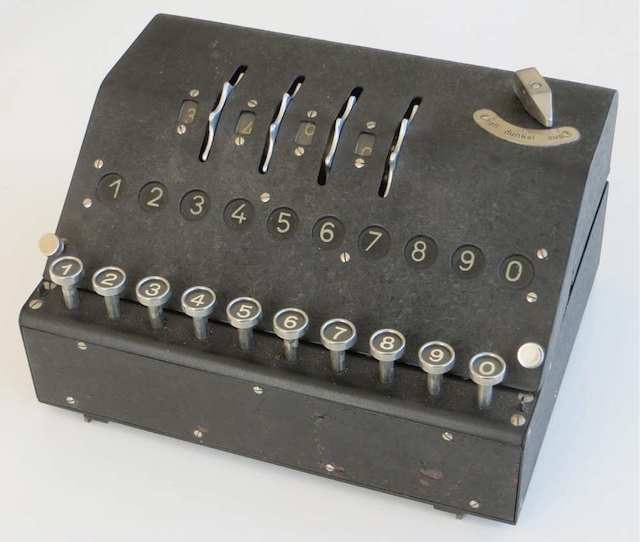
The existence of the Z30 first became known after the publication of an article in a Spanish magazine Arthuro Quirantes (April 2004). Judging by the documents that were found in the Spanish archives, the car was offered to the government in November 1931 along with other models.
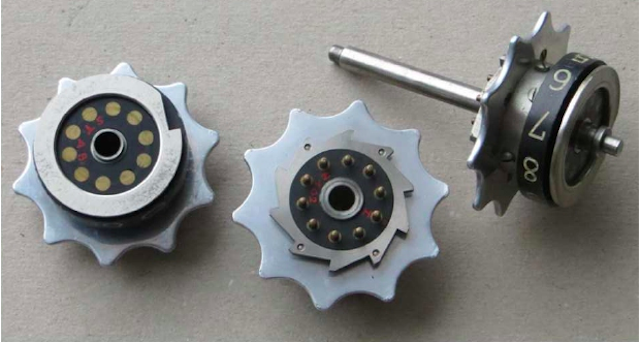

Enhanced Version Z30
In 1930, the Polish Ciphering Bureau, Biuro Szyfrów (a special unit of Polish military intelligence), was the first to attempt to crack the Enigma cipher. Being the closest neighbors of Germany, they knew very well about the dangers of another. The study of the commercial version of Enigma has begun.
The bureau hired three young brilliant mathematicians from the University of Poznan: Marian Reevsky, Jerzy Ruzicki and Heinrich Zygalsky. They then began to work on the Enigma cipher, having only a few intercepted messages.
Marian Reevsky tackled the problem at the end of 1932, and a few weeks later achieved the first breakthrough: he dismantled the Enigma secret internal wiring. Together with his colleagues, he began to develop various techniques for decrypting German traffic.

Cyclometer Reevsky
Heinrich Zygalsky developed the so-called sheets of Zigalsky. Later, the Zygalsky sheet method was automated - creating the legendary Bomba.
Their success was based on purely mathematical analysis, which was facilitated by the information received from a German spy named Hans-Tilo Schmidt (codename Asche), as well as the commercial Enigma, intercepted by Polish mail. They later acquired the commercial Enigma and used all the information gathered to convert the machine into a military one. This converted machine became the well-known Polish Enigma.
Starting in 1930, the Germans used a very simple key management scheme, a randomly selected message key was sent twice in encrypted form at the beginning of each message. This made it possible to relatively easily recover the daily key using manual methods.
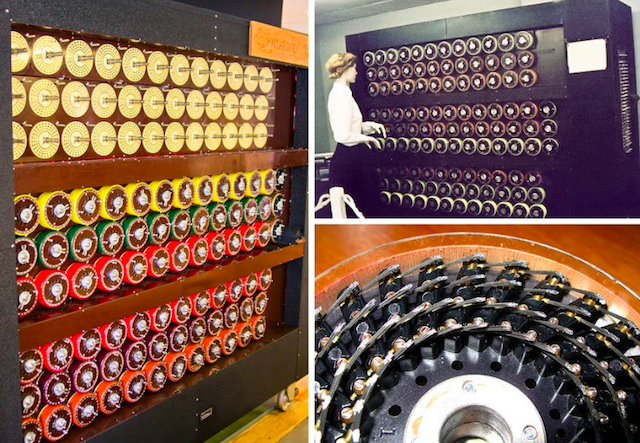
Cryptological Bombe is the British response to the German Enigma.
Based on the information provided by the Poles, British mathematician Alan Turing developed the legendary Turing-Welchman Bombe. A more advanced version of the cryptological Bomb - an electronic-mechanical machine for decrypting Enigma code.
In wartime, 212 Bombe machines were installed in Bletchley Park , with their help it was possible to decrypt up to 3 thousand messages a day. After the war, all Bombe were destroyed. After 60 years, with the help of detailed drawings and descriptions for them, the car was restored, it took 10 years of work.
Before and during World War II, Enigma was an inspiration for the development of other crypto machines, such as the British Typex and the American Sigaba. And even after World War II, some cryptographic machines were based on the same principle as Enigma. This is an American KL-7, Russian violet and Swiss Nema.
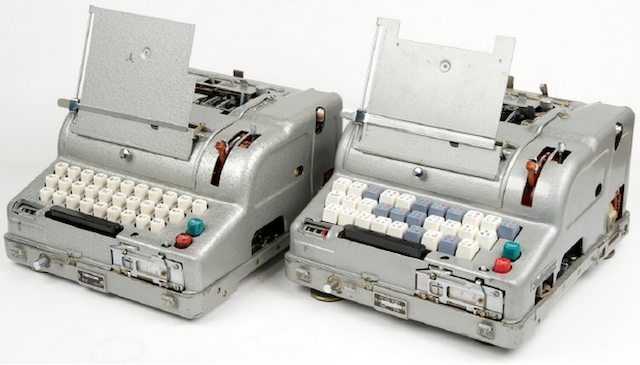
Thank you for staying with us. Do you like our articles? Want to see more interesting materials? Support us by placing an order or recommending it to your friends, a 30% discount for Habr users on a unique analogue of entry-level servers that we invented for you: The whole truth about VPS (KVM) E5-2650 v4 (6 Cores) 10GB DDR4 240GB SSD 1Gbps from $ 20 or how to divide the server?(options are available with RAID1 and RAID10, up to 24 cores and up to 40GB DDR4).
VPS (KVM) E5-2650 v4 (6 Cores) 10GB DDR4 240GB SSD 1Gbps until the summer for free when paying for a period of six months, you can order here .
Dell R730xd 2 times cheaper? Only we have 2 x Intel TetraDeca-Core Xeon 2x E5-2697v3 2.6GHz 14C 64GB DDR4 4x960GB SSD 1Gbps 100 TV from $ 199 in the Netherlands! Dell R420 - 2x E5-2430 2.2Ghz 6C 128GB DDR3 2x960GB SSD 1Gbps 100TB - from $ 99! Read about How to Build Infrastructure Bldg. class using Dell R730xd E5-2650 v4 servers costing 9,000 euros for a penny?

Only a few copies of Enigma, the most complex cryptographic machine of the Hitler Reich, were able to survive the war: loyal soldiers of the fascist army, surrendering, destroyed it by the thousands. Today, few can tell about the encryption technique used in the legendary "Riddle".

After the troops of the Southwestern and Stalingrad fronts closed the encirclement ring in 1943 (the Stalingrad cauldron, in which there was an almost 300,000th enemy group), the radio operator German Kledits was fortunate enough to remain outside the encirclement. The radio operator received the last message encrypted on Enigma from the comrades who were in the boiler. He still remembers its contents: in a cramped basement we are fighting X The enemy took up flamethrowers X Let Germany live. Then another clear-text message came: convey respect to my parents.

The German government, struck by the reliability of the machine, retained all rights to it for itself and began to use it for the army. Enigma was the most sophisticated encryption system used by the Germans during World War II. To communicate via Morse’s radio channel with troops at the front, soldiers used a much simpler system: double encryption.
German Kledits, born in 1921, and Jürgen Reinhold, born in 1923, are among the few surviving witnesses who were able to talk about their work with Enigma of our time.

Under the Wehrmacht, Kledits in 1939 learned to be a telephone operator, and then a radio operator. At first he served in France in an infantry division, with which he went to the East in 1941. Inside, units worked only with double encryption. At the beginning of 1942 he was transferred to the intelligence unit, which was engaged in wiretapping and analysis of Soviet messages transmitted by wireless telegraph. Subsequently, the unit advanced through the territory of the USSR, conducting radio interception and using advanced technologies, the last point was Stalingrad.
Kledits was a radio operator. Analysis of intercepted messages was carried out by other specialists (mainly mathematicians) of the same unit. German had little contact with them and did not know anything about their secret work. And today, information about the work of German cryptographers in World War II is extremely fragmented.
However, Kledits could have guessed what his colleagues were doing. As a radio operator, he was faced with the task of transmitting messages to the military headquarters via the Morse apparatus. To prevent these strictly confidential data from falling into the hands of the enemy, they were encrypted using Enigma. As Kledits recalls, three people were always responsible for encryption: one entered the appropriate letters on Enigma, the second encrypted the result, and the third wrote it down.

For the transmission of encrypted messages to occur correctly, the radio operator had to set the correct key (consisting of digital combinations). Each detachment had a list of codes with them, from which each time an officer took a part to pass on to a radio operator. Such a key was valid for 24 hours.
“We were convinced that Enigma could not be hacked,” said Jürgen Reinhold, one of the specialists of another unit. He was drafted in 1941, served in the intelligence department in the tank troops, for which he studied for nine months. At the same time, he studied Morse code, learned double encryption and working with Enigma. The Germans used several tens of thousands of this device during World War II - not knowing that the British were listening and decrypting most of the messages.
Jürgen Reinhold had no idea about this. For the transmission of the most important strategic and state-important messages of Enigma there was a choice of “namber van”. Only after it became known about Enigma's vulnerability did they return to the double encryption method. How it worked from the Reinhold story: it was necessary to look for vertical pairs of numbers in fields A and B, form a quadrangle, form the next quadrangle, and enter the result in five-digit groups of characters in Morse code.

The difference is in the use of Enigma and double encryption on the face: the cipher was the size of a typewriter and, accordingly, too bulky for camping equipment, and therefore unsuitable for soldiers who fought at the front and moved on foot. The "paper and pencil" process used in double encryption was the best alternative for such units. In addition, front news was often very old in a couple of hours, and even the best crackers of the enemy’s code couldn’t work so fast.
In November 1942, the Kleditsa detachment arrived at Stalingrad. There, a radio group was visited by a group of Romanian intelligence officers. They were impressed by the work of the legendary Enigma. “Ah, la machina dechifrata!” - that’s what fell off their lips, because they were also delighted with the high security of the device, not suspecting that the British had long been able to break into Enigma.
Soon after the military success of the USSR and the Stalingrad boiler, the Kleditsa unit was dispersed. The retreat began. In Czechoslovakia, a scattered group gathered again in order to destroy their copy of Enigma on May 9, 1945. Even during the exercises, radio operators were taught some things: Enigma should never fall into the hands of the enemy, and the encryption key recorded on paper should be eaten during a disaster. Radio operators even practiced "eating" paper.
Jürgen Reinhold survived the end of the war in Hungary. Even after the war ended on May 8, 1945, he still used a cryptographic machine. He wanted to leave Hungary and get to the British, but was afraid of the Red Army. Using messages encrypted on Enigma, he, under the guidance of former comrades, was able to reach his destination. His cipher machine model was reliable: the device always worked flawlessly from start to finish. After Jurgen, taking the hammer, destroyed the last Enigma.
Since most soldiers destroyed their Enigma, only a couple of copies of the crypto machine have survived to date. Collectors are willing to pay about 20,000 euros for the legendary Enigma, and the cost of special models is even higher.
Simplicity of design, high reliability, and most importantly excellent cipher durability are the parameters that have made the Enigma cryptographic machine known for centuries. The electromechanical encoder first appeared after the First World War. In 1917, the American Edward Hepburn created a rotary encryption machine, it was later called "Enigma". She connected to an electric typewriter. In 1923, the Berlin engineer Arthur Sherbius created an independent industrial version of Enigma.
Over time, a special modification designed for the naval forces saw the light, it differed from the usual Enigma in the number of encryption rotors.
A large family of different Enigma machines was developed between 1923 and 1945. Conventionally, a family can be divided into two branches: machines with a more complex mechanism — they output information directly to paper, and simpler ones that are produced with incandescent lamps.

Enigma With
Enigma A - Die Handelsmaschine (commercial machine) was a printing encryption machine developed in 1923 by Scherbius & Ritter in Berlin (Germany). This was the first encryption device manufactured under the Enigma brand. As far as we know, there are currently no surviving examples of this model. The insecurity of the Enigma A printing mechanism led to the development of a new machine model in 1924.
Schreibende enigma
The new model has a lettering lever (Typenhebel) - exactly the same as a conventional typewriter. Due to mechanical and manufacturing problems, the “introduction” of the crypto machine was delayed until 1926. In 1926, it was replaced by Die Schreibende Enigma (printed Enigma).
Machine with 4 encryption rotors and 28 electrical contacts on each side, with a gear mechanism with stepwise displacement. In addition, each gear wheel had a different number of teeth, which ensured a long encryption period and irregular (i.e., less predictable) stepping. Four encryption rotors were installed inside the machine, their initial position was set by 4 handles (on the right). By inserting the handle into the fifth handle (located at the very top), the entire encryption mechanism could be started. Above the encryption rotors was a 5-digit counter, with its help the number of characters entered on the keyboard was counted.

On the front of the crypto machine there was a knob for choosing 3 modes: encryption, decryption, and plain text. If the “plain text” mode was set, Enigma worked like a simple typewriter.
At the top of the machine, at the back, was a functioning printer, like a standard electric typewriter of that era. It consisted of a paper carriage and a petal printer. When creating encrypted text, characters were printed in groups of 5 letters each, after which a space was automatically set. One such line fit ten such groups (50 characters). On the keyboard were letters, numbers, punctuation marks, and a space. Two Shift keys were used to switch between letters and numbers.
Schreibende Enigma was subject to mechanical problems, so it was decided to develop another model. It was introduced in 1929 and became known as the Enigma Model H29 or simply Enigma H. H29 is the latest model in the Enigma series of printing machines. But, alas, these models were unreliable, and, despite improvements, in practice they received a lot of complaints.
Enigma a
It was Enigma A, which was initially much smaller and cheaper, turned into Enigma I - the main encryption device of the German army during the Second World War. Portable Enigma A was placed in a wooden box, it was first used light bulbs.
In November 1924, the car could be purchased for $ 500. With the purchase of 10 or more units, the price was $ 420, and for bulk purchases from 50 units - $ 400. It is known that there were several options for the car, but none of them survived.

According to the description in the surviving documents, this is exactly what Enigma A looked like (photo above). Its dimensions were 27 x 23 x 13 cm, and weight about 5 kg. The keyboard consisted of 26 keys, divided into two rows. Above each row were corresponding bulbs. The keys were empty, any character could be entered on top.
Enigma b
Enigma B, an electromechanical encryption rotary machine, was introduced at the end of 1924 by Cipher Machine Corporation (ChiMaAG) in Berlin (Germany). Like its predecessor Enigma A, bulbs were used here.

Two versions of Enigma B are known: an early version with two rows of keys in front and two rows of bulbs above the rotors; two fixed encryption rotors and a movable contact reflector in the center.

In a later version, one encryption rotor was removable. The keyboard was arranged a little differently than a conventional typewriter, the characters were arranged in alphabetical order. The lamp panel was now in the center of the machine, and the rotors moved back.
The letter W was missing; Å, Ä and Ö were added in the lower right corner. At that time, W was not used in the official Swedish language, with the exception of names, foreign words and borrowings, and in this case it could also be replaced by VV (double-V).

It is believed that surviving examples of the early Model B do not exist. But there are at least two copies of the later model (A-133 and A-134), they have become part of the collection. The differences between the two versions are so great that the later one is more likely a transition to Enigma C.

Inside the A-133, the
A-133 had three moving encryption rotors - one letter (AO) and the other two numbers (01-28) - and a fixed reflector (FM) mounted to the left of the rotors. The number of possible settings is 2 891 341 824.
Enigma C

The Enigma C, an electromechanical rotary encryption machine, was introduced in mid-1925 by Cipher Machine Corporation (ChiMaAG) in Berlin (Germany). Like its predecessors, Enigma A and Enigma B, it used bulbs.

Components of Enigma C: 26-letter keyboard for entering open messages; 26 light bulbs, which when turned on illuminated the desired letters of the ciphertext; power source (3.5-volt battery or its equivalent); three removable contact wheels that rotated on a common axis; fixed contact reflector; fixed input contact wheel.
Military Enigma
Enigma I is an electromechanical encryption machine developed in the years 1927/29 for the German army and put into operation in 1932. The basis was taken Enigma D, was added a fixed reflector and a control panel in front. The machine was used during the Second World War and was known under various names. Since December 1938, Enigma supplied with five disks instead of three: three - in the car, two remote. The German military insisted on making changes that significantly increased the durability of the machine. The most important of these was the introduction of the switch, which was located under the keyboard. 26 switch connectors were connected in pairs by 13 short cables. This device made it possible at the input and output stages to swap the letters of the alphabet that make up the pairs.

This instance was found in Italy, in a train among lost luggage at the end of World War II.
Enigma I was used by both the Army and the Air Force, later the German Navy, it was known here as M1, M2, M3. The only obvious difference between the army version and the navy version was that the wheels of the latter had letters (AZ) instead of numbers. Various manufacturers produced about 20,000 of these military vehicles, but only a few have survived to this day.
Until 1932, all Enigma commercial models were freely available on the international market. Later, all commercial and international sales were approved by the German army. Enigma H was sold to the Hungarian army, but was never popular due to the high price. In addition, the Germans continued to sell Enigma to the Swiss and Dutch armies.
The first Enigma machines were developed in 1923 by Scherbius and Ritter, later renamed the Gewerkschaft Securitas (Security Association), and a few later into AG cryptographic machines. After the death of Sherbius in 1929, the company passed into the hands of another owner, in 1933 the German army acquired the rights to manufacture the Enigma machine and the company name was again changed to Heimsoeth and Rinke.
Enigma z
A rather unusual variation of Enigma. Although its design was clearly based on Enigma D, it only had 10 keys and 10 lamps, each of which is indicated by numbers from 0 to 9. It was used to encrypt numeric messages (that is, messages that were previously encoded), for example reports about weather. The letter Z probably stood for Ziffern or Zahlen (numbers). The official name of the crypto machine is Z30. In total, there were two versions of Enigma Z: standard and improved.

The existence of the Z30 first became known after the publication of an article in a Spanish magazine Arthuro Quirantes (April 2004). Judging by the documents that were found in the Spanish archives, the car was offered to the government in November 1931 along with other models.


Enhanced Version Z30
Polish Breakthrough (1933)
In 1930, the Polish Ciphering Bureau, Biuro Szyfrów (a special unit of Polish military intelligence), was the first to attempt to crack the Enigma cipher. Being the closest neighbors of Germany, they knew very well about the dangers of another. The study of the commercial version of Enigma has begun.
The Poles were the first to be alarmed. Watching the dangerous neighbor, in February 1926 they suddenly could not read the encryption of the German Navy, and since July 1928 - and the encryption of the Reichswehr. It became clear: there they switched to machine encryption.
The bureau hired three young brilliant mathematicians from the University of Poznan: Marian Reevsky, Jerzy Ruzicki and Heinrich Zygalsky. They then began to work on the Enigma cipher, having only a few intercepted messages.
Marian Reevsky tackled the problem at the end of 1932, and a few weeks later achieved the first breakthrough: he dismantled the Enigma secret internal wiring. Together with his colleagues, he began to develop various techniques for decrypting German traffic.

Cyclometer Reevsky
Heinrich Zygalsky developed the so-called sheets of Zigalsky. Later, the Zygalsky sheet method was automated - creating the legendary Bomba.
Their success was based on purely mathematical analysis, which was facilitated by the information received from a German spy named Hans-Tilo Schmidt (codename Asche), as well as the commercial Enigma, intercepted by Polish mail. They later acquired the commercial Enigma and used all the information gathered to convert the machine into a military one. This converted machine became the well-known Polish Enigma.
Starting in 1930, the Germans used a very simple key management scheme, a randomly selected message key was sent twice in encrypted form at the beginning of each message. This made it possible to relatively easily recover the daily key using manual methods.

Cryptological Bombe is the British response to the German Enigma.
Based on the information provided by the Poles, British mathematician Alan Turing developed the legendary Turing-Welchman Bombe. A more advanced version of the cryptological Bomb - an electronic-mechanical machine for decrypting Enigma code.
In wartime, 212 Bombe machines were installed in Bletchley Park , with their help it was possible to decrypt up to 3 thousand messages a day. After the war, all Bombe were destroyed. After 60 years, with the help of detailed drawings and descriptions for them, the car was restored, it took 10 years of work.
The principle of operation of the decoder developed by Turing consisted of enumerating possible options for the cipher key and attempts to decrypt the text if the structure of the decrypted message or part of the plaintext was known.
Before and during World War II, Enigma was an inspiration for the development of other crypto machines, such as the British Typex and the American Sigaba. And even after World War II, some cryptographic machines were based on the same principle as Enigma. This is an American KL-7, Russian violet and Swiss Nema.

Thank you for staying with us. Do you like our articles? Want to see more interesting materials? Support us by placing an order or recommending it to your friends, a 30% discount for Habr users on a unique analogue of entry-level servers that we invented for you: The whole truth about VPS (KVM) E5-2650 v4 (6 Cores) 10GB DDR4 240GB SSD 1Gbps from $ 20 or how to divide the server?(options are available with RAID1 and RAID10, up to 24 cores and up to 40GB DDR4).
VPS (KVM) E5-2650 v4 (6 Cores) 10GB DDR4 240GB SSD 1Gbps until the summer for free when paying for a period of six months, you can order here .
Dell R730xd 2 times cheaper? Only we have 2 x Intel TetraDeca-Core Xeon 2x E5-2697v3 2.6GHz 14C 64GB DDR4 4x960GB SSD 1Gbps 100 TV from $ 199 in the Netherlands! Dell R420 - 2x E5-2430 2.2Ghz 6C 128GB DDR3 2x960GB SSD 1Gbps 100TB - from $ 99! Read about How to Build Infrastructure Bldg. class using Dell R730xd E5-2650 v4 servers costing 9,000 euros for a penny?
